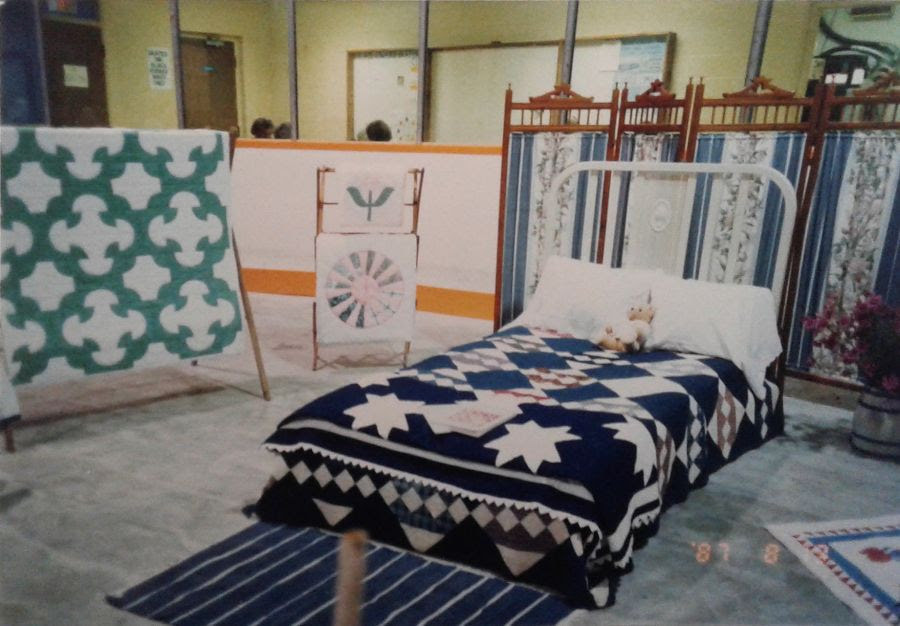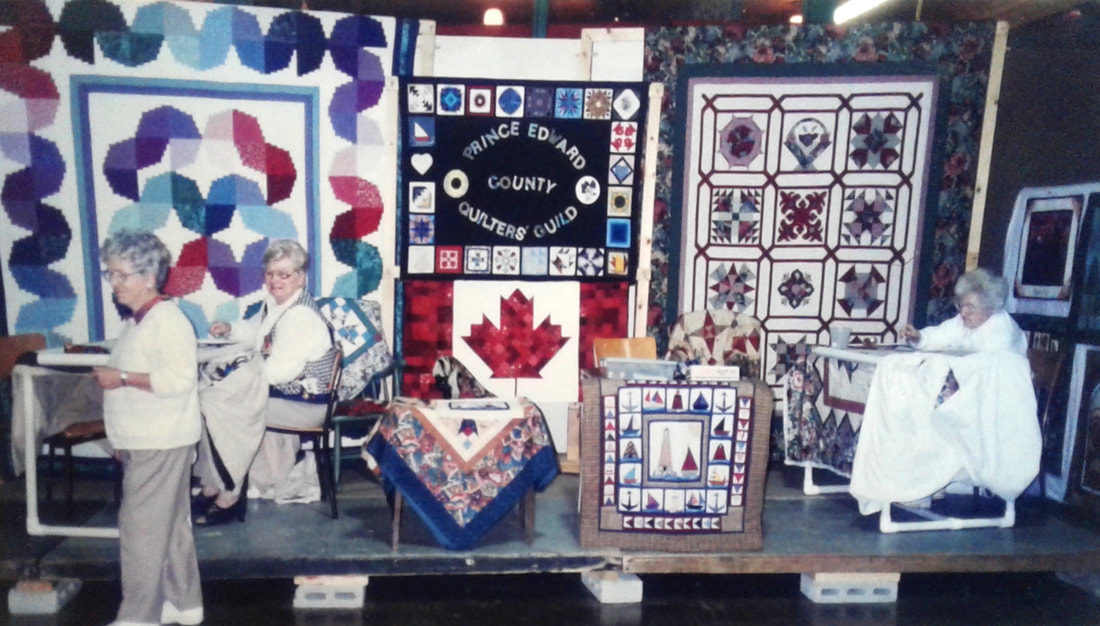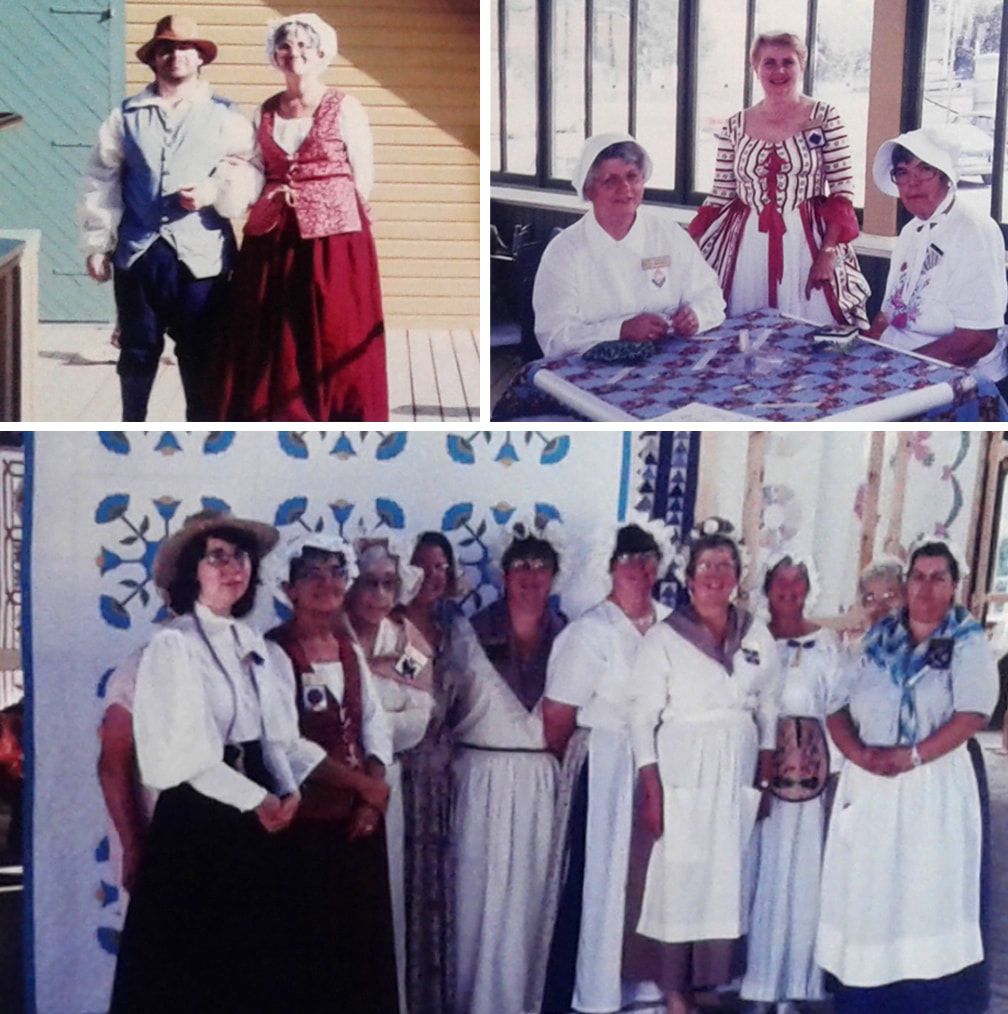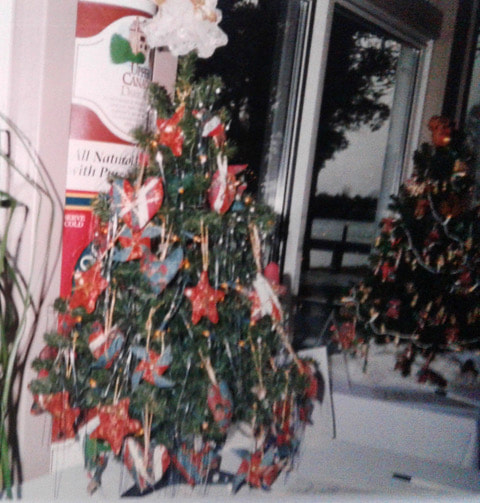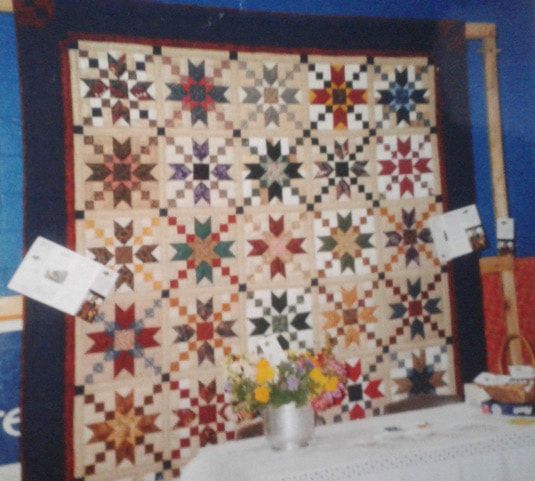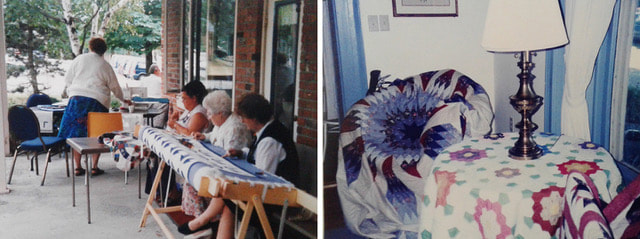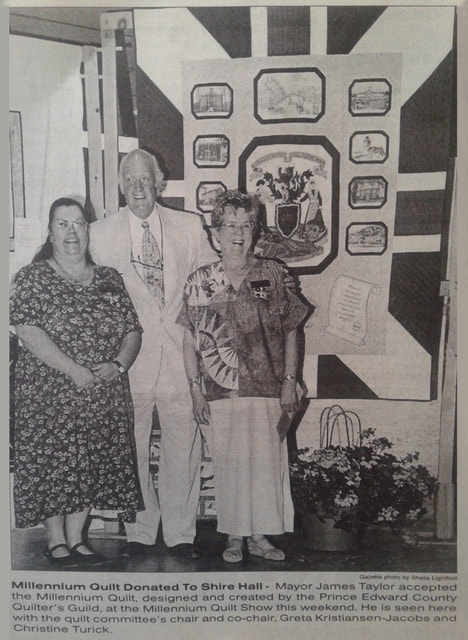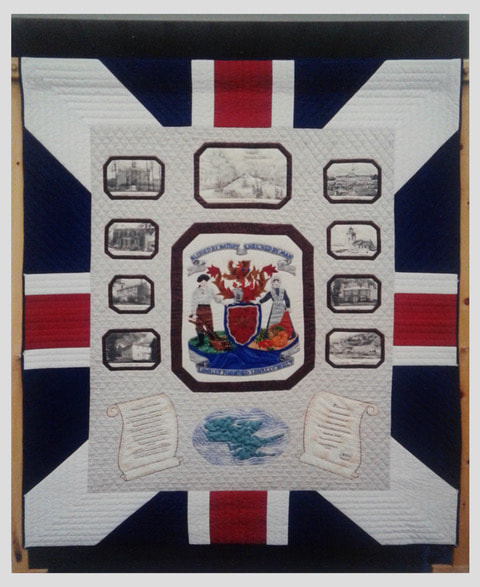Prince Edward County Quilters' Guild History
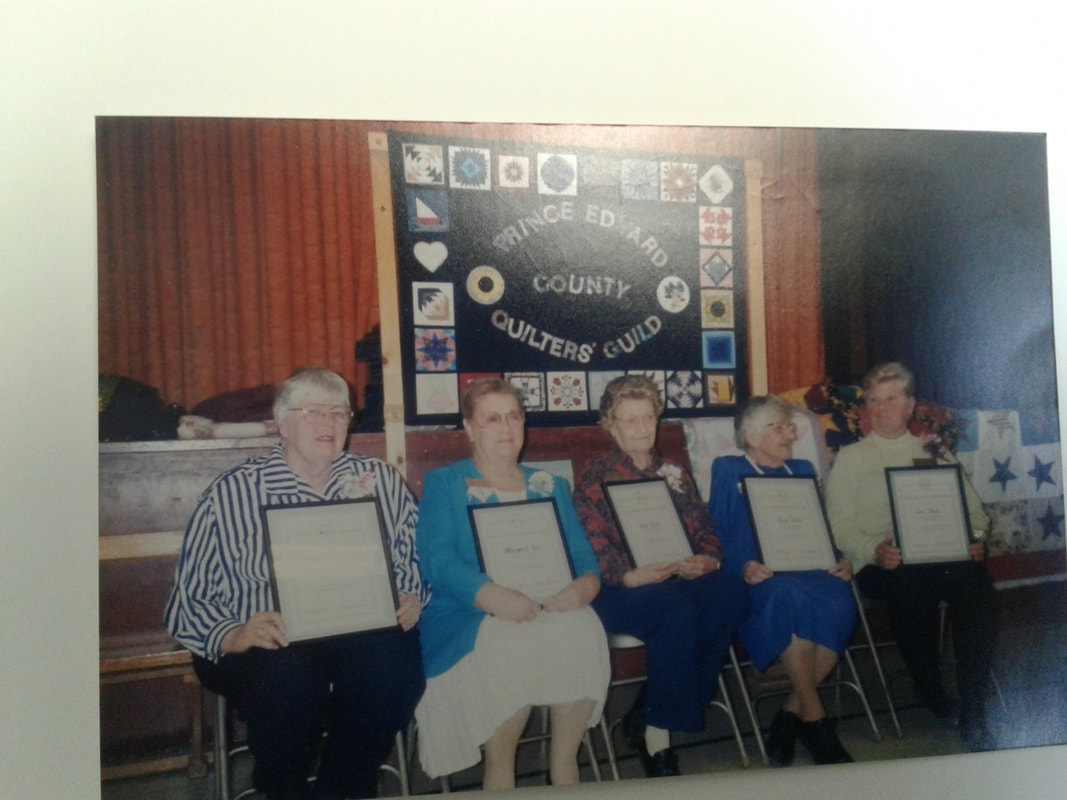
Founding of the Guild
By Greta Kristiansen
Before the mid-80s and late 70s, quilting in Canada was very much a one-woman hobby. Women would make quilts, quilt them individually or bring them to groups that had floor racks set up for quilting bees, generally in church halls or basements.
After American’s Bicentennial in 1976, there was an explosion in the quilting world. Suddenly there were magazines, books, shows, quilt stores, quilting fabric, instructions and tools available and every woman interested in sewing and needlework jumped on the bandwagon.
1985 - MOVING BEYOND A 'ONE-WOMAN HOBBY'
In 1985, Joan O’Neill moved to Picton, having spent the previous 14 years in the Toronto area professionally arranging Art & Craft shows. She had made quilts for years and belonged to two guilds, Rouge Valley and Scarborough. The County was exactly in the one-woman hobby syndrome and Joan was itching to start a guild.
Marlene King, Joan's next door neighbour, becomes her resource person and introduces Joan to Beth Hicks, known as "The County Quilter.”
During the 40s through to the 80s, the CNE in Toronto invited Ontario quilters to submit quilts for their show. Prizes and ribbons were awarded and Beth Hicks won many times. Beth in turn introduce Joan to her sister-in-law, Nina Hicks, a different kind of quilter. Nina made quilts to sell to earn herself some pin money. She lived in Cherry Valley and had a perpetual sign on the road saying “Quilts for Sale.”
Ruth Geary belonged to the group of quilters at the Lake-on-the-Mountain Church and was eager to join in. Unfortunately she died two years later in 1988.
Margaret Kerr lived on Big Island and was a self-taught quilter. Her husband had a serious stroke which affected his mobility leaving him house-bound for 18 years, which also left Margaret in the same situation.
Last but not least, Mary-Lou Norton joined. She was president of the Women’s Institute in Bloomfield and also the area representative for the Institute for the Quinte Region.
1986 - BEGINNING OF THE GUILD
These six women, under Joan O’Neill’s tutelage, started the Prince Edward County Quilt Guild and through Mary-Lou’s connection with the Women’s Institute, several women were brought into the fold and in no time the group consisted of 15-20 women.
Mary-Lou was a valuable addition to the group, for while Joan had the vision, Mary-Lou was the executioner. She was an organizer that got things done and at her suggestion they called themselves “The Prince Edward County Quilters’ Guild” and Mary-Lou was named president.
She opened a competition for the members to design a logo for the guild. The members voted on the entries and the winner was Jackie Adams, whose logo we still have today.
Initially the quilters met at Joan’s house, but as the group grew, other facilities were needed and so they moved to The Edu-Centre on Stanley Street, Bloomfield, across from the Baxter Centre. Later, as the group further grew they moved to Pinecrest School, Bloomfield, first in the library and later in the gym. This arrangement lasted until 2016, when the guild moved to Bethany Christian Reformed Church, Bloomfield where we are today.
Before the mid-80s and late 70s, quilting in Canada was very much a one-woman hobby. Women would make quilts, quilt them individually or bring them to groups that had floor racks set up for quilting bees, generally in church halls or basements.
After American’s Bicentennial in 1976, there was an explosion in the quilting world. Suddenly there were magazines, books, shows, quilt stores, quilting fabric, instructions and tools available and every woman interested in sewing and needlework jumped on the bandwagon.
1985 - MOVING BEYOND A 'ONE-WOMAN HOBBY'
In 1985, Joan O’Neill moved to Picton, having spent the previous 14 years in the Toronto area professionally arranging Art & Craft shows. She had made quilts for years and belonged to two guilds, Rouge Valley and Scarborough. The County was exactly in the one-woman hobby syndrome and Joan was itching to start a guild.
Marlene King, Joan's next door neighbour, becomes her resource person and introduces Joan to Beth Hicks, known as "The County Quilter.”
During the 40s through to the 80s, the CNE in Toronto invited Ontario quilters to submit quilts for their show. Prizes and ribbons were awarded and Beth Hicks won many times. Beth in turn introduce Joan to her sister-in-law, Nina Hicks, a different kind of quilter. Nina made quilts to sell to earn herself some pin money. She lived in Cherry Valley and had a perpetual sign on the road saying “Quilts for Sale.”
Ruth Geary belonged to the group of quilters at the Lake-on-the-Mountain Church and was eager to join in. Unfortunately she died two years later in 1988.
Margaret Kerr lived on Big Island and was a self-taught quilter. Her husband had a serious stroke which affected his mobility leaving him house-bound for 18 years, which also left Margaret in the same situation.
Last but not least, Mary-Lou Norton joined. She was president of the Women’s Institute in Bloomfield and also the area representative for the Institute for the Quinte Region.
1986 - BEGINNING OF THE GUILD
These six women, under Joan O’Neill’s tutelage, started the Prince Edward County Quilt Guild and through Mary-Lou’s connection with the Women’s Institute, several women were brought into the fold and in no time the group consisted of 15-20 women.
Mary-Lou was a valuable addition to the group, for while Joan had the vision, Mary-Lou was the executioner. She was an organizer that got things done and at her suggestion they called themselves “The Prince Edward County Quilters’ Guild” and Mary-Lou was named president.
She opened a competition for the members to design a logo for the guild. The members voted on the entries and the winner was Jackie Adams, whose logo we still have today.
Initially the quilters met at Joan’s house, but as the group grew, other facilities were needed and so they moved to The Edu-Centre on Stanley Street, Bloomfield, across from the Baxter Centre. Later, as the group further grew they moved to Pinecrest School, Bloomfield, first in the library and later in the gym. This arrangement lasted until 2016, when the guild moved to Bethany Christian Reformed Church, Bloomfield where we are today.
PEC Quilt Guild Show
by Greta Kristiansen
Our first three quit shows were annual, after 1990 they became biennial.
1988 Show
The Guild was started in 1986 by Joan O’Neill and five other women, one of whom was Mary-Lou Norton, who became the Guild’s first president and Quilt Show Chair.
Mary-Lou was a formidable, no-nonsense woman, a great organizer who did not suffer fools easily. She always reminded me of the school teachers I had in the 30s, when children stood at attention when the teacher spoke.
There is an old Viking saying when referring to someone who not only is strong-willed but is also able to transfer his will onto others: “You wouldn’t want to bite spoons with him.” I have no idea of the origin of this saying - did the old Vikings have spoon biting contests? Were they tin spoons or wooden spoons? - I don’t know, but everybody understood the meaning of the saying.
Mary-Lou was that kind of person. Mary Lou wanted a quilt show in 1988 whether the Guild was ready or not, and so the Guild had one. And accordingly, the Picton Arena was rented.
Compared to today's elaborate display, the show was simple and sparse and rather pathetic. We had a very limited amount of quilts. The guild was still in its infancy at only 20-25 members and not yet a cohesive group. We had no racks. Quilts were draped over the arena boards, chairs and tables used as props were provided by the members. Quilts were even laid out on the arena floor.
It was truly a learning experience.
1989 Show
Mary-Lou is still president and Quilt Show Chair. At her insistence we would have a second show, even though the Guild only had about 25-30 members and not enough quilts.
To compensate for this lack of quilts, an invitation (plea) was sent to County residents to lend their
quilts, which in turn were displayed in groups representing their respective townships: Athol, Hallowell, Ameliasburgh, South and North Marysburgh etc., etc.
This did help to fill the arena. However, we still did not have racks and aside from using the arena boards and props, ropes
were also strung across the arena. Rather amateurish and certainly not professional.
1990 Show
Dot Stevenson is elected President and Quilt Show Chair. By then the Guild was 35-40 members.
Dot was also an organizer who got things done, but with a much softer approach and her first agenda item for the show was racks, racks and racks. Dot had seen a picture of an American show where displays were on wooden racks, a picture clear enough to ascertain the construction of the rack.
She involved her husband Frank and her uncle and they made the first lot of racks. What a successful element to the show, which went from amateur to professional and also resulted in quite a few new members joining the Guild.
Our first three quit shows were annual, after 1990 they became biennial.
1988 Show
The Guild was started in 1986 by Joan O’Neill and five other women, one of whom was Mary-Lou Norton, who became the Guild’s first president and Quilt Show Chair.
Mary-Lou was a formidable, no-nonsense woman, a great organizer who did not suffer fools easily. She always reminded me of the school teachers I had in the 30s, when children stood at attention when the teacher spoke.
There is an old Viking saying when referring to someone who not only is strong-willed but is also able to transfer his will onto others: “You wouldn’t want to bite spoons with him.” I have no idea of the origin of this saying - did the old Vikings have spoon biting contests? Were they tin spoons or wooden spoons? - I don’t know, but everybody understood the meaning of the saying.
Mary-Lou was that kind of person. Mary Lou wanted a quilt show in 1988 whether the Guild was ready or not, and so the Guild had one. And accordingly, the Picton Arena was rented.
Compared to today's elaborate display, the show was simple and sparse and rather pathetic. We had a very limited amount of quilts. The guild was still in its infancy at only 20-25 members and not yet a cohesive group. We had no racks. Quilts were draped over the arena boards, chairs and tables used as props were provided by the members. Quilts were even laid out on the arena floor.
It was truly a learning experience.
1989 Show
Mary-Lou is still president and Quilt Show Chair. At her insistence we would have a second show, even though the Guild only had about 25-30 members and not enough quilts.
To compensate for this lack of quilts, an invitation (plea) was sent to County residents to lend their
quilts, which in turn were displayed in groups representing their respective townships: Athol, Hallowell, Ameliasburgh, South and North Marysburgh etc., etc.
This did help to fill the arena. However, we still did not have racks and aside from using the arena boards and props, ropes
were also strung across the arena. Rather amateurish and certainly not professional.
1990 Show
Dot Stevenson is elected President and Quilt Show Chair. By then the Guild was 35-40 members.
Dot was also an organizer who got things done, but with a much softer approach and her first agenda item for the show was racks, racks and racks. Dot had seen a picture of an American show where displays were on wooden racks, a picture clear enough to ascertain the construction of the rack.
She involved her husband Frank and her uncle and they made the first lot of racks. What a successful element to the show, which went from amateur to professional and also resulted in quite a few new members joining the Guild.
Early organizers
1990 Dot Stevenson – President
Also an organizer who got things done
Dot and her mother, Dorothy Dunn (always known as Mrs. Dunn) attended the 1988 show and both joined after that. In 1990 Dot was elected president, the guild had about 35-40 members, still a very loosey-goosey group. Dot Stevenson was also elected 1990 Quilt Show Chair and after the show, Vicky LaFleur and I joined the guild.
CONSTITUTION – Dot suggested that the guild should adapt a constitution to form the basis for its purpose and its activities. Met with resistance, (of course) but Dot did her homework, studied constitutions from other guilds and presented a proposal which after much discussion was finally approved. If the constitution was the guild’s foundation, Dot was its backbone.
1992 Jean Wood – President
Vicky and I were elected secretary and treasurer respectively.
FINANCES were in terrible shape. The guild was operating a $1300 deficit, constantly using what little money the shows had generated. Dot had changed the fees from $3.00 to $5.00 when she became president – much opposition. I suggested the fee should be $15 in order for the guild to be self-sustaining. My name was mud, I was taken aside and talked to:
“Half the membership would quit – couldn’t afford this exorbitant increase.”
Newsletters were handwritten by Phyllis Sawyer whose handwriting was very legible. Photocopying, envelopes and postage were our biggest expense items. There were no computers or typewriters; agendas and minutes were also handwritten. We had hall rental to pay, we provided coffee and tea, treats were prepared and paid for by members on a rotating basis; and even at $3.00 annual fee we had complaints about no juice.
We couldn’t afford speakers or workshops. Meetings were group tables, sewing, sharing knowledge and ideas. An increase to $15 was finally accepted and we did not lose any members.
MINUTES became typewritten after Vicky assumed the secretary position.
1992 Quilt Show – Flora Walton, Chair
Flora had an artistic flair, full of ideas and a FEATURE CONCEPT was introduced. Her husband Tom and Jean’s husband Ron made some more racks presumably using the same model as Frank and Dot’s uncle. The two sets were not compatible, didn’t quite fit together, a concept we all struggled with for years.
BED QUILTS was the feature concept and members were asked to bring in headboards, preferably old looking and beds were made from cardboard boxes, props were also used. A challenge was issued for baby quilts: 30-40 baby quilts were displayed and prizes were awarded.
LOGO BAGS - 100 bags were made with our logo, sold to public and members for $5.00.
RAFFLE QUILT was introduced, generating funds for programs & workshops.
VIEWER’S CHOICE was also introduced. It was a big mistake as there were no control mechanisms, only voting slips by a voting box. People voted 5-6 times. The more relatives, the more votes. There were more votes than attendees!
Aside from that, the show was a huge success and Flora put us on the map.
Also an organizer who got things done
Dot and her mother, Dorothy Dunn (always known as Mrs. Dunn) attended the 1988 show and both joined after that. In 1990 Dot was elected president, the guild had about 35-40 members, still a very loosey-goosey group. Dot Stevenson was also elected 1990 Quilt Show Chair and after the show, Vicky LaFleur and I joined the guild.
CONSTITUTION – Dot suggested that the guild should adapt a constitution to form the basis for its purpose and its activities. Met with resistance, (of course) but Dot did her homework, studied constitutions from other guilds and presented a proposal which after much discussion was finally approved. If the constitution was the guild’s foundation, Dot was its backbone.
1992 Jean Wood – President
Vicky and I were elected secretary and treasurer respectively.
FINANCES were in terrible shape. The guild was operating a $1300 deficit, constantly using what little money the shows had generated. Dot had changed the fees from $3.00 to $5.00 when she became president – much opposition. I suggested the fee should be $15 in order for the guild to be self-sustaining. My name was mud, I was taken aside and talked to:
“Half the membership would quit – couldn’t afford this exorbitant increase.”
Newsletters were handwritten by Phyllis Sawyer whose handwriting was very legible. Photocopying, envelopes and postage were our biggest expense items. There were no computers or typewriters; agendas and minutes were also handwritten. We had hall rental to pay, we provided coffee and tea, treats were prepared and paid for by members on a rotating basis; and even at $3.00 annual fee we had complaints about no juice.
We couldn’t afford speakers or workshops. Meetings were group tables, sewing, sharing knowledge and ideas. An increase to $15 was finally accepted and we did not lose any members.
MINUTES became typewritten after Vicky assumed the secretary position.
1992 Quilt Show – Flora Walton, Chair
Flora had an artistic flair, full of ideas and a FEATURE CONCEPT was introduced. Her husband Tom and Jean’s husband Ron made some more racks presumably using the same model as Frank and Dot’s uncle. The two sets were not compatible, didn’t quite fit together, a concept we all struggled with for years.
BED QUILTS was the feature concept and members were asked to bring in headboards, preferably old looking and beds were made from cardboard boxes, props were also used. A challenge was issued for baby quilts: 30-40 baby quilts were displayed and prizes were awarded.
LOGO BAGS - 100 bags were made with our logo, sold to public and members for $5.00.
RAFFLE QUILT was introduced, generating funds for programs & workshops.
VIEWER’S CHOICE was also introduced. It was a big mistake as there were no control mechanisms, only voting slips by a voting box. People voted 5-6 times. The more relatives, the more votes. There were more votes than attendees!
Aside from that, the show was a huge success and Flora put us on the map.
1994 Mollie Lacey – President
1994 Quilt Show – Dot Stevenson & Flora Walton Co-Chairs
Judged Competitions are introduced – Judges, Lydia Quigley & Liz Lake
Two Categories: Pieced or appliqued - Bed-sized quilts and a few wall hangings, all hand quilted. Viewer’s Choice ballots were given with each ticket purchase.
FEATURE- King and his appliqued quilts (Flora’s idea), I can’t recall his full name or background
The King quilts filled the back of the arena, the public loved them, and he sold quite a few all in $1000 range.
-Members were not happy, felt his quilts diminished theirs and reduced their sales.
-Big mistake, never repeated again.
-Also invited adjacent guild to display a quilt
Floor frame set up for hand quilting. Public invited to take a stitch.
From a public perspective the show was extremely successful.
1993-4 Jane Sheppard, new member
Jane’s background was art and she was starting to introduce fibre arts pieces and created The Quinte Fibre Artist. Initially there was Jane, Joan Reive, Marlene Mead, Anne Thompson, Marjorie Whitehead and myself. It has since grown into a fabulous arts group, with its own shows bi-annually at Parrot Gallery. I'm proud to say that the group originated in PECQG.
BANNER
Jane Sheppard introduced the concept of a guild banner that would be displayed at meetings and other events. She proposed that she and Joan Reive design the banner and that members submit 5” blocks to surround the centre. From blocks submitted, Jane & Joan chose 24 blocks and a prize was given to the best block which was won by Phyllis Sawyer.
1996 Greta Kristiansen – President
The Guild was maturing and Greta was keen to expand internal activities and to introduce out-reach programs.
Expansion of Internal Activities
-Block-of-the-month
-In-house-challenges
-Mystery quilts
-Round Robin quilts
-Workshops (in-house and external teachers)
-Trunk Shows (in-house and external)
-President's Challenge
New Outreach Programs
-Charity/Comfort Quilts
-The Amazing Loyalist Adventure
-Festival of Trees
-Hands-On Shows
-Picton Fair
-Breast Cancer Quilts “The Quilt”
-Nominates G.I.F.T. (Garratt’s Island) and Alternatives for Women as the Guild’s designated charities. Ensures that the press is invited for major donation presentations.
The County Wall Hanging
The guild had an In-house challenge to make a wall hanging depicting the County and Chris Turick, a talented and prolific quilter won the competition with her beautiful little green quilt that gets shown with the banner. Someone recently pointed out to me that it does not show the wineries. Well, they weren't there in 1996.
1994 Quilt Show – Dot Stevenson & Flora Walton Co-Chairs
Judged Competitions are introduced – Judges, Lydia Quigley & Liz Lake
Two Categories: Pieced or appliqued - Bed-sized quilts and a few wall hangings, all hand quilted. Viewer’s Choice ballots were given with each ticket purchase.
FEATURE- King and his appliqued quilts (Flora’s idea), I can’t recall his full name or background
The King quilts filled the back of the arena, the public loved them, and he sold quite a few all in $1000 range.
-Members were not happy, felt his quilts diminished theirs and reduced their sales.
-Big mistake, never repeated again.
-Also invited adjacent guild to display a quilt
Floor frame set up for hand quilting. Public invited to take a stitch.
From a public perspective the show was extremely successful.
1993-4 Jane Sheppard, new member
Jane’s background was art and she was starting to introduce fibre arts pieces and created The Quinte Fibre Artist. Initially there was Jane, Joan Reive, Marlene Mead, Anne Thompson, Marjorie Whitehead and myself. It has since grown into a fabulous arts group, with its own shows bi-annually at Parrot Gallery. I'm proud to say that the group originated in PECQG.
BANNER
Jane Sheppard introduced the concept of a guild banner that would be displayed at meetings and other events. She proposed that she and Joan Reive design the banner and that members submit 5” blocks to surround the centre. From blocks submitted, Jane & Joan chose 24 blocks and a prize was given to the best block which was won by Phyllis Sawyer.
1996 Greta Kristiansen – President
The Guild was maturing and Greta was keen to expand internal activities and to introduce out-reach programs.
Expansion of Internal Activities
-Block-of-the-month
-In-house-challenges
-Mystery quilts
-Round Robin quilts
-Workshops (in-house and external teachers)
-Trunk Shows (in-house and external)
-President's Challenge
New Outreach Programs
-Charity/Comfort Quilts
-The Amazing Loyalist Adventure
-Festival of Trees
-Hands-On Shows
-Picton Fair
-Breast Cancer Quilts “The Quilt”
-Nominates G.I.F.T. (Garratt’s Island) and Alternatives for Women as the Guild’s designated charities. Ensures that the press is invited for major donation presentations.
The County Wall Hanging
The guild had an In-house challenge to make a wall hanging depicting the County and Chris Turick, a talented and prolific quilter won the competition with her beautiful little green quilt that gets shown with the banner. Someone recently pointed out to me that it does not show the wineries. Well, they weren't there in 1996.
1996 QUILT SHOW – Dot Stevenson, Chair
Competitions were more fine-tuned and more categories were introduced. Again Lydia Quigley and Liz Lake are the judges. We also introduced door prizes, donated by local stores.
We invited the Kingston Heirloom Guild to show one of their quilts and it won “Viewer’s Choice”.
In-house featured quilters were introduced. Selected participants were given 3 racks forming a U at the back of the arena plus a table and could of course also bring their own props; they were also expected to spend the majority of the show time in their booth to answer questions. They were written up in the show program and it turned out to be very successful aspect.
A large wooden floor frame was set up for quilting demonstrations, and there was lots of interest.
Demonstrations of various techniques were provided by selected members, 3 demos Saturday and Sunday mornings and 3 demos Saturday afternoon. Well attended.
Dot had done it again, put together a successful show.
1996 CHARITY/COMFORT QUILTS
American guilds were making charity quilts and the concept started to catch on in Canada and the guild decided to get involved and a committee was struck. Initially members would bring any blocks and UFOs that they weren’t going to finish and the committee would assemble them into quilt tops, but not necessarily sew them together. Blocks meant to make a quilt were put in plastic bags, handed out to members who would sew them together using their own fabrics for sashing, borders and sometimes filler strips to re-size the block. The finished tops were given back to the committee and the guild would supply batting and backings. Groups of hand-quilters would meet at PFW, set up plastic floor racks and periodically 8-10 members would meet at the Edu-Centre for the day and machine quilt. Others would square up and bind. Alternatives for Women was our designated recipient and at every quilt show, we would present them with 20 to 25 finished quilts and have the press present.
1996 THE PICTON FAIR
Chris Turick was heavily involved in the Picton Fair and suggested that the guild take a display booth. We did demonstrations of various techniques and had plastic floor frames with hand quilters. We also introduced the concept of giving a free one year membership in the guild to whoever won “Best of Fair” quilt. A couple of years later we introduced a competition for children from 5-12 years old with the little ones producing crayon pictures of quilts and the older ones some sort of sewed item. We gave nominal prizes of $2.00, $3.00 & $5.00.
We have participated in the Fair ever since 1996.
Competitions were more fine-tuned and more categories were introduced. Again Lydia Quigley and Liz Lake are the judges. We also introduced door prizes, donated by local stores.
We invited the Kingston Heirloom Guild to show one of their quilts and it won “Viewer’s Choice”.
In-house featured quilters were introduced. Selected participants were given 3 racks forming a U at the back of the arena plus a table and could of course also bring their own props; they were also expected to spend the majority of the show time in their booth to answer questions. They were written up in the show program and it turned out to be very successful aspect.
A large wooden floor frame was set up for quilting demonstrations, and there was lots of interest.
Demonstrations of various techniques were provided by selected members, 3 demos Saturday and Sunday mornings and 3 demos Saturday afternoon. Well attended.
Dot had done it again, put together a successful show.
1996 CHARITY/COMFORT QUILTS
American guilds were making charity quilts and the concept started to catch on in Canada and the guild decided to get involved and a committee was struck. Initially members would bring any blocks and UFOs that they weren’t going to finish and the committee would assemble them into quilt tops, but not necessarily sew them together. Blocks meant to make a quilt were put in plastic bags, handed out to members who would sew them together using their own fabrics for sashing, borders and sometimes filler strips to re-size the block. The finished tops were given back to the committee and the guild would supply batting and backings. Groups of hand-quilters would meet at PFW, set up plastic floor racks and periodically 8-10 members would meet at the Edu-Centre for the day and machine quilt. Others would square up and bind. Alternatives for Women was our designated recipient and at every quilt show, we would present them with 20 to 25 finished quilts and have the press present.
1996 THE PICTON FAIR
Chris Turick was heavily involved in the Picton Fair and suggested that the guild take a display booth. We did demonstrations of various techniques and had plastic floor frames with hand quilters. We also introduced the concept of giving a free one year membership in the guild to whoever won “Best of Fair” quilt. A couple of years later we introduced a competition for children from 5-12 years old with the little ones producing crayon pictures of quilts and the older ones some sort of sewed item. We gave nominal prizes of $2.00, $3.00 & $5.00.
We have participated in the Fair ever since 1996.
1996 THE AMAZING LOYALIST ADVENTURE
This 3-day event was introduced in the County in 1996, held every September for 10 years, and was very successful. Organizations, businesses, farms, museums, schools and churches all participated for a fee and the public paid $20 for an entry pass for all 3 days. The guild participated in the opening year. The Crystal Place was rented and vintage quilts were collected from all over the County to honour the spirit of the Loyalists. Guild members that were part of the show all wore period costumes. The first picture shows Charles & Mollie Lacey arriving dressed as proper landed gentry, a gentleman and his lady; an absolute wonderful and exciting day.
1996-98 Greta Kristiansen, President
1996 FESTIVAL OF TREES
Our Founder, Joan O’Neill was heavily involved with raising funds for G.I.F.T., a local arm of Garratt’s Island, the camp for children with life-threatening diseases. The camp was run by the Trillium Foundation and G.I.F.T. was responsible for the maintenance of the buildings, the upkeep of the grounds, the docks, boats and the barge that connected to the island.
Joan O’Neill together with Manson Slik was one of the co-founders of the Festival of Trees, starting the first year with only 40 trees.
The guild decided to get involved and put in its first tree in 1996. Members made co-ordinated ornaments and have continued to participate ever since. All proceeds originally went to G.I.F.T. and initially all entries were just trees, however, over the years the festival has grown to a highly successful event with up to 300 entries, becoming more and more elaborate with time. G.I.F.T became the guild`s designated charity and $1,000 was donated every year. One year Joan was instrumental in convincing the splinter group the Ps & Qs to make a full sized quilt that was raffled off to G.I.F.T for $1,000.
In time the entire project was taken over by Trillium and the proceeds from the festival now go to PEC hospital.
1996- 97 HANDS-ON SHOW
Joan of course does not rest on her laurels. She introduces the “Hands On-Show” at the Isaiah Tubbs resort as a summer show to raise money for G.I.F.T. There was a Silent Auction of items made, as the title suggested, by hand. The guild participated and was given the Hepburn building for their display as well as an outside area for quilting demonstrations. The weather was perfect both years and they were exciting and successful events.
MAPLE LEAF FLAG
Geraldine Rorabeck, another one of our talented quilters, designed and made the wonderful Maple Leaf flag for display on Canada Day in her store, Picton Fabric World. The guild convinced her to part with it since we thought it appropriate to display at shows.
The Banner, The County Hanging, and the Maple Leaf Flag have become part of our identity.
1998 QUILT SHOW - Dot Stevenson & Chris Turick, Co-Chairs
By now we are starting to feel that we have quilt shows under our belt.
Competitions with various categories were judged by Bette Procunier and Lucy Anne Holliday from Toronto. Aside from in-house featured quilters, we now also invited an outside quilt artist as the show's featured artist. A large U-shaped area was allocated at the back of the arena for this. The artist was advertised and also written up in the programs. Great addition to the show.
SILENT AUCTION was introduced to further raise money for G.I.F.T. Members were asked to make small wall hangings for the shows, any theme, any colour, their choice and donate these wall hangings to the guild. Our expectation was 25-30 quilts and it was generally met. The Silent Auction was a success and always raised more than $1000, one year even in excess of $1300. Phyllis Sawyer’s daughter, Tracy was the auctioneer for the first two shows and Pat Stzuke the third time.
1996 FESTIVAL OF TREES
Our Founder, Joan O’Neill was heavily involved with raising funds for G.I.F.T., a local arm of Garratt’s Island, the camp for children with life-threatening diseases. The camp was run by the Trillium Foundation and G.I.F.T. was responsible for the maintenance of the buildings, the upkeep of the grounds, the docks, boats and the barge that connected to the island.
Joan O’Neill together with Manson Slik was one of the co-founders of the Festival of Trees, starting the first year with only 40 trees.
The guild decided to get involved and put in its first tree in 1996. Members made co-ordinated ornaments and have continued to participate ever since. All proceeds originally went to G.I.F.T. and initially all entries were just trees, however, over the years the festival has grown to a highly successful event with up to 300 entries, becoming more and more elaborate with time. G.I.F.T became the guild`s designated charity and $1,000 was donated every year. One year Joan was instrumental in convincing the splinter group the Ps & Qs to make a full sized quilt that was raffled off to G.I.F.T for $1,000.
In time the entire project was taken over by Trillium and the proceeds from the festival now go to PEC hospital.
1996- 97 HANDS-ON SHOW
Joan of course does not rest on her laurels. She introduces the “Hands On-Show” at the Isaiah Tubbs resort as a summer show to raise money for G.I.F.T. There was a Silent Auction of items made, as the title suggested, by hand. The guild participated and was given the Hepburn building for their display as well as an outside area for quilting demonstrations. The weather was perfect both years and they were exciting and successful events.
MAPLE LEAF FLAG
Geraldine Rorabeck, another one of our talented quilters, designed and made the wonderful Maple Leaf flag for display on Canada Day in her store, Picton Fabric World. The guild convinced her to part with it since we thought it appropriate to display at shows.
The Banner, The County Hanging, and the Maple Leaf Flag have become part of our identity.
1998 QUILT SHOW - Dot Stevenson & Chris Turick, Co-Chairs
By now we are starting to feel that we have quilt shows under our belt.
Competitions with various categories were judged by Bette Procunier and Lucy Anne Holliday from Toronto. Aside from in-house featured quilters, we now also invited an outside quilt artist as the show's featured artist. A large U-shaped area was allocated at the back of the arena for this. The artist was advertised and also written up in the programs. Great addition to the show.
SILENT AUCTION was introduced to further raise money for G.I.F.T. Members were asked to make small wall hangings for the shows, any theme, any colour, their choice and donate these wall hangings to the guild. Our expectation was 25-30 quilts and it was generally met. The Silent Auction was a success and always raised more than $1000, one year even in excess of $1300. Phyllis Sawyer’s daughter, Tracy was the auctioneer for the first two shows and Pat Stzuke the third time.
1998-2000 – Lyne Lusk, President
1998-99 was a time where the country was obsessing about Millennium projects and the County was no different. Greta Kristiansen, who had travelled extensively throughout the United States, had noticed that many State Welcome Centres displayed quilts depicting important history of that particular state. Consequently she suggested that the guild make a quilt depicting our Loyalist Heritage. The quilt would be presented to The Corp of PEC in honour of the Millennium and would hang in Shire Hall in perpetuity.
Millennium Quilt Project
The quilt would be a whole cloth quilt, displaying points of historic interest set in the Loyalist flag. The idea was presented to the membership and was met with little enthusiasm except from Chris Turick, one of our more accomplished quilters. Since this would be a whole cloth quilt, and it would be hard to divide the projects between members, Chris and Greta made the quilt top and the other members quilted it.
THE COUNTY The whole project depended upon a commitment from the Corp of PEC to accept and display the quilt, so Greta approached Mayor James Taylor showing him a draft proposal of the quilt and he was instantly on board.
COST The guild committed $400 for the quilt, but we also needed another $800 for a ventilated display cabinet and got a commitment from Mr. Taylor that the town would pick up that cost if we couldn’t get the funds from a Millennium grant. We applied for the grant, but were refused.
DESIGN The centre would be the County's Coat of Arms. Chris obtained a picture and enlarged to the size needed, then transferred the image to fabric. Chris, who was an incredible hand-embroiderer, painstakingly hand embroidered it following the exact colours.
RESEARCH I spent considerable time at the County archives under the Court House scouring their files for information and with input from David Taylor, the County’s resident historian (also my neighbour) finally settled upon a fantastic drawing from 1869 of Picton Main Street, too perfect not to include. Picton was represented by The Macauley House, Bloomfield by the Boarding School , Wellington by Tara Hall and the County by the Court House and the Crystal Palace, White Chapel (oldest church) and Salmon Point Lighthouse ( oldest Lighthouse). Mr. David Taylor vouched for me at the Court House to take these images out for photocopying and to have them transferred onto cloth at Printcraft. There is a scroll on the quilt giving a brief outline of who the Loyalists were and another one stating that the quilt was presented to the Corp. by the guild. Finally at the bottom, an image of the Quinte Isle. The whole thing was then set in the Loyalist Flag which resembles the Union Jack minus the red corner stripes representing Ireland which was not part of the union at that time. Quilted by guild members.
Millennium Show Presented to the Corp of PEC at the Millennium Show and accepted by Mayor Taylor. A beautiful ventilated Oak Display case was installed at Shire Hall for the quilt.
There were lots of press releases on the progression of the quilt and the press was also present for the presentation. The quilt was appraised at $2165.00 by Rita Rottman, qualified AQS appraiser.
A binder is available in the Guild’s library telling the story of the project.
1998-99 was a time where the country was obsessing about Millennium projects and the County was no different. Greta Kristiansen, who had travelled extensively throughout the United States, had noticed that many State Welcome Centres displayed quilts depicting important history of that particular state. Consequently she suggested that the guild make a quilt depicting our Loyalist Heritage. The quilt would be presented to The Corp of PEC in honour of the Millennium and would hang in Shire Hall in perpetuity.
Millennium Quilt Project
The quilt would be a whole cloth quilt, displaying points of historic interest set in the Loyalist flag. The idea was presented to the membership and was met with little enthusiasm except from Chris Turick, one of our more accomplished quilters. Since this would be a whole cloth quilt, and it would be hard to divide the projects between members, Chris and Greta made the quilt top and the other members quilted it.
THE COUNTY The whole project depended upon a commitment from the Corp of PEC to accept and display the quilt, so Greta approached Mayor James Taylor showing him a draft proposal of the quilt and he was instantly on board.
COST The guild committed $400 for the quilt, but we also needed another $800 for a ventilated display cabinet and got a commitment from Mr. Taylor that the town would pick up that cost if we couldn’t get the funds from a Millennium grant. We applied for the grant, but were refused.
DESIGN The centre would be the County's Coat of Arms. Chris obtained a picture and enlarged to the size needed, then transferred the image to fabric. Chris, who was an incredible hand-embroiderer, painstakingly hand embroidered it following the exact colours.
RESEARCH I spent considerable time at the County archives under the Court House scouring their files for information and with input from David Taylor, the County’s resident historian (also my neighbour) finally settled upon a fantastic drawing from 1869 of Picton Main Street, too perfect not to include. Picton was represented by The Macauley House, Bloomfield by the Boarding School , Wellington by Tara Hall and the County by the Court House and the Crystal Palace, White Chapel (oldest church) and Salmon Point Lighthouse ( oldest Lighthouse). Mr. David Taylor vouched for me at the Court House to take these images out for photocopying and to have them transferred onto cloth at Printcraft. There is a scroll on the quilt giving a brief outline of who the Loyalists were and another one stating that the quilt was presented to the Corp. by the guild. Finally at the bottom, an image of the Quinte Isle. The whole thing was then set in the Loyalist Flag which resembles the Union Jack minus the red corner stripes representing Ireland which was not part of the union at that time. Quilted by guild members.
Millennium Show Presented to the Corp of PEC at the Millennium Show and accepted by Mayor Taylor. A beautiful ventilated Oak Display case was installed at Shire Hall for the quilt.
There were lots of press releases on the progression of the quilt and the press was also present for the presentation. The quilt was appraised at $2165.00 by Rita Rottman, qualified AQS appraiser.
A binder is available in the Guild’s library telling the story of the project.
